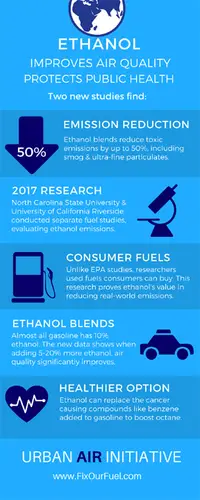New Studies Again Show Ethanol Reduces Toxic Emissions and Improves Air Quality +VIDEO
 Two thumbs up for two new studies |
By Marc J. Rauch
Exec. Vice President/Co-Publisher
THE AUTO CHANNEL
It's incredible how many people, and all those connected in some manner to the American Petroleum Institute, continue to spout the wildly incorrect claim that ethanol causes more harmful emissions than gasoline or petroleum diesel fuel. The most simple and best way to illustrate the difference in how the substances burn is in this video:
And yet, even after watching a demonstration like this, and studies that have been conducted several decades, people will claim that ethanol is dirtier than gasoline or petro-diesel. It is mind-boggling.
Well now, there are two new studies that prove ethanol blends reduce toxic tailpipe emissions... by up to 50%, which significantly improves air quality and protects public health.
The separate studies were conducted by the North Carolina State University (NCSU) and the University of California Riverside (UCR). The Urban Air Initiative (UAI) commissioned both independent studies to evaluate tailpipe emissions using fuels similar to what consumers can buy at the gas station, instead of laboratory created test fuels.
 |
The report issued by Urban Air Initiative, sponsors of the studies, states that today, 97% of gasoline in the United States contains 10% ethanol (E10). The new data from these studies provide evidence that air quality can be significantly improved when you add more ethanol to gasoline, creating higher blends with between 15% (E15) and 30% (E30) ethanol.
For example, the NCSU study compares a regular E10 gasoline bought in Raleigh, North Carolina to that same fuel with ethanol simply added, making it an E25. The E25 had a 30-40% reduction in ultrafine particulates (UFP's), one of the most toxic emissions recorded. The E25 also reduced carbon monoxide by 15-30% and carbon emissions by up to 5%. Another positive result was that E25 had no change in NOx emissions compared to E10 using both Flex Fuel and Non Flex Fuel vehicles.
The NOx data was even better in the UCR study. It showed a 10-30% reduction in NOx. This is a key difference from EPA designed studies that show ethanol blends raise NOx, according to UAI Technical Director Steve Vander Griend.
"By simply adding ethanol to current gasoline, this testing demonstrated the benefits of ethanol as a cleaner, higher octane fuel. The fact that these studies used consumer fuels and real world driving conditions is the most accurate reflection of what happens on the road every single day. It's this kind of science that will help give consumers more access to a healthier fuel," said Vander Griend.
While both studies focused on what comes out of the tailpipe, the UCR study went a step further to evaluate the impact emissions have on air quality after leaving the tailpipe. Researchers found ethanol blends reduce toxic emissions by up to 50%, this includes smog and ultra-fine particulates. It also found that aromatics like benzene and toluene added to gasoline to boost octane directly raise emissions, while ethanol added to fuel decreases emissions. This study compared E10, E30 and E85 fuels and found the best results with the higher ethanol blends.
"This testing is about as real world as we can get when it comes to fuel blending and it is clear ethanol can significantly improve public health. The studies further validates the importance of splash blending, or simply adding ethanol to gasoline for fuel testing," Vander Griend said.
The NCSU study is one of the first to look at real world fuels and real world driving conditions when evaluating tailpipe emissions. Researchers used Portable Emission Measurement System (PEMS) equipment to validate the benefits of ethanol. The data from both of these studies was presented at different workshops last month. They will both be peer reviewed and published later this year.


